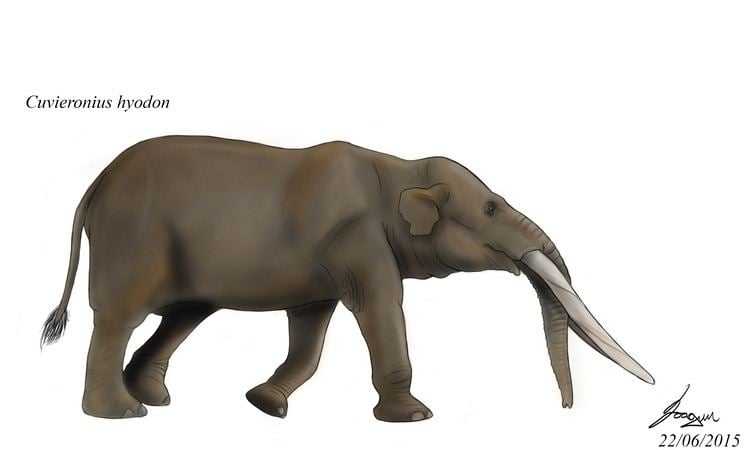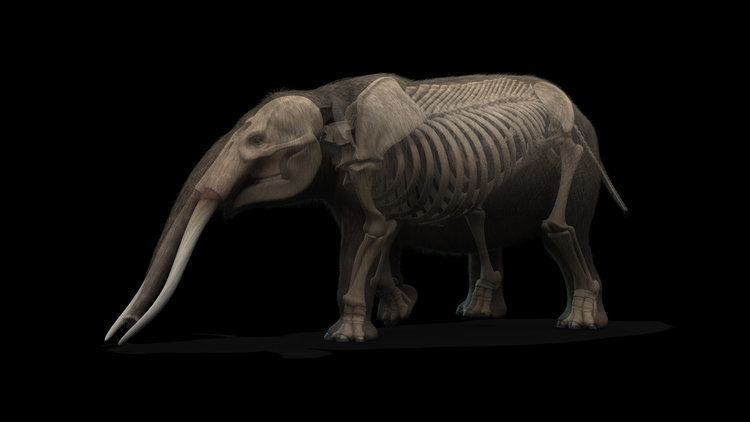Family †Gomphotheriidae Rank Genus | Phylum Chordata | |
Similar Stegomastodon, Cuvieronius hyodon, Gomphothere, Proboscidea, Haplomastodon | ||
Cuvieronius is an extinct New World genus of gomphothere and is named after the French naturalist Georges Cuvier. Alive, species stood, on average, about 2.3 m (7.5 ft) tall at the shoulder, weighed about 3.5 tonnes (3.9 tons) and would have superficially resembled modern elephants with spiral-shaped tusks.
Contents

Cuvieronius
History of discovery

The species now known as Cuvieronius hyodon was among the first fossil animals from the new world to be studied. The first remains of this species were recovered from Ecuador by Alexander von Humboldt, at a location the local population referred to as the "Field of Giants". Humboldt recognized that, rather than being bones of giant humans as had been thought by the local population and previous Spanish colonists, they were similar to the giant elephants (Mastodon) being described from Ohio. Humboldt sent teeth that he had collected from Mexico, Ecuador, and Chile to French anatomist Georges Cuvier, who classified the teeth into two species, which he referred to as the "mastodonte des cordilières" and the "mastodonte humboldien", in an 1806 paper. It was not until 1824 that Cuvier formally named the species. He referred both to the genus Mastodon, calling them M. andium and M. humboldtii.

Unbeknownst to Cuvier, Fischer had, in 1814, already named the two species based on Cuvier's original description, in the new genus Mastotherium as M. hyodon and M. humboldtii. The idea of two distinct species continued to be accepted into the 20th Century, usually using Cuvier's names, though Fischer's names were older. In 1923, Henry Fairfield Osborn recognized that these species were distinct from Mastodon, and assigned each to its own new genus, as Cuvieronius humboldtii and Cordillerion andium. However, by the 1930s, general agreement had shifted to regard both forms as representing a single, geographically widespread species, with Cuvieronius humboldtii considered to be the correct name. During the 1950s, the nomenclature of this species became increasingly tangled, as various scientists regarded the type species of the genus Cuvieronius to be Fischer's first published name Mastotherium hyodon, rather than the originally designated Mastodon humboldtii. This situation went unaddressed until 2009, when Spencer Lucas petitioned the International Commission on Zoological Nomenclature to officially change the type species of Cuvieronius to M. hyodon as had been followed for over 50 years by that time, rather than abandoning the well-known Cuvieronius as a synonym. In 2011, Opinion 2276 of the ICZN ruled to conserve the names.
Origin

This animal initially evolved in North America about 5.3—5.2 million years ago (AEO) with fossil evidence uncovered in at the Tehuichila site in Hidalgo, Mexico. During the Great American Interchange of around 3 million years ago, Cuvieronius and two species of its sister genus Stegomastodon moved south into South America. They were the only proboscid mammals to colonize South America. living as far south as Chile, with specimens unearthed at the Quereo I site (Quereo Quebrada) dating to the Late Pleistocene 11,600—11,400 BP.
North America

The oldest fossil remains to date are of Cuvieronius species found in Lincoln County, Nevada, which date to an accurate 4.6 million years ago (AEO). It was also found as far east as South Carolina and North Carolina from 1.81 million—126,000 years ago. In Florida, remains show both Cuvieronius sp. and C. tropicus living from 3.7—1.5 million years ago (AEO). The most recent findings of Cuvieronius sp. in North America are in Sonora, Mexico, with findings dated at 13,390 BP.
South America
Remains of Cuvieronius have been found in association with man, and pieces of its hide and muscle tissue have been found in Chile: “The site has also yielded 38 small pieces of animal hide and muscle tissue, some still preserved on bones of Cuvieronius. Pieces of hide were also recovered from hearth areas, living floors, and wooden structural remains. Some pieces were still attached to wooden poles, possibly suggesting the presence of hide-draped huts. Pathological and other analyses of these pieces suggest that they are also of a proboscidean.” South American fossils formerly attributed to mastodons are now believed to be Cuvieronius.
The related Stegomastodon occupied warmer, lower-altitude habitats in South America, while the smaller C. hyodon occupied cooler, higher-altitude Andean habitats.
Cuvieronius was a mixed feeder, and has been dated at least as recently as 9,100 BP in Monte Verde, Chile,. By the end of the Pleistocene, the northern limit of the range of Cuvieronius was in Mexico.
